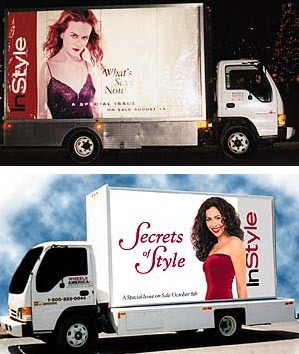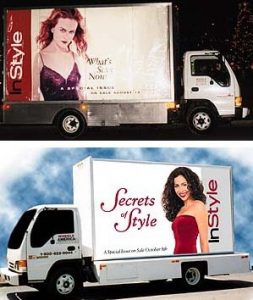As out-of-home advertising continues to grow in popularity, its boundaries are also expanding. A relative newcomer to out-of-home is third-party truck advertising. While companies have long used their fleets to advertise their own products, many trucks now serve a dual purpose: They transport one product and advertise another.
In essence, truck or fleet advertising transforms a truck, or fleet of trucks, into a veritable canvas on wheels. The graphics are typically applied in two forms: either self-adhesive vinyl or flexible-face fabric attached using an installed extrusion system. The graphics are usually screen or digitally printed and mounted to the truck in a matter of hours.
Why trucks?
Trucksides are used for the same reasons advertisers include other out-of-home media in their advertising repertoire.
• Impact: Trucks are hard to miss.
• Reach: Trucks carry messages to areas other media cannot reach. Unlike stationary billboards, truckside billboards move.
Advertisement
• Cost: Trucks drive a hard bargain, at 68* cents per 1,000 impressions. Compare that to $14.50 for a 1/3-page, black-and-white newspaper ad, or $18.90 to run a local, 30-second television spot (both based on 1,000 impressions).
• Flexibility: The use of self-adhesive vinyl graphics, as well as vinyl "billboards" attached to trucksides with an extrusion system, allow advertising on trucks to be easily changed and/or reused.
Who’s in the driver’s seat?
Several companies have developed new technologies for truck advertising. For example, Wheels America Adv.’s (Wilkes-Barre, PA) MobilBoards incorporate a patent-pending, backlit illumination process that is particularly effective at night. These billboards can be changed in as little as half an hour, allowing advertisers to buy one-day advertisements. Already used for The Philadelphia Inquirer, Six Flags, InStyle magazine and AdWeek magazine, Wheels America aims to cover 150-200 trucks in 20 markets over the next two years.
Haverford Systems’ (Downington, PA) HavaVision™ big-screen video billboards are being used by Fox Sports, Easyrider magazine and the NFL. The product is available in two formats. One version is a 23-by-13-foot LED screen that unfolds out of the back of an 18-wheel tractor-trailer, and sets up in minutes. The other version, called HavaVision Mobile, uses the driver’s side of the "cargo area" on a 31-foot, two-axle truck inset with two 10-foot-diagonal video screens. The screens can be used independently or joined to form one 16-foot-long image.
Truck tracking
Advertisement
How do you track these advertisements’ success? MediaVehicles, for instance, has its own proprietary software, RADAR™, which stands for Road-type Allocation and Density-based Allotments Report. This tracking device reportedly gives an accurate measurement of the number of trucks needed to generate a specific showing in a given market. Based on the Federal Highway Administration’s most current statistics for local traffic density, RADAR provides market-specific allotments for 390 urban areas.
Additionally, a group of companies, including ATX Technologies, GML Inc., 3M Industrial Adhesives & Tapes Div. and Visitech Inc., have begun an independent study in Minneapolis, with plans to expand to other markets for field-testing a state-of-the-art trailer-tracking system. This tracking system, based on the Global Positioning System (GPS), was developed by ATX Technologies and will reportedly enable users to locate any given truck at any time.
From the out-of-home industry’s point of view, trucks are truly one of the last bastions of pure third-party advertising, providing a clean, uncluttered message right in front of your face.
*Source: MediaVehicles, Atlanta. Information for this article was provided by the Traffic Audit Bureau and MediaVehicles.



 Tip Sheet2 weeks ago
Tip Sheet2 weeks ago
 Photo Gallery3 days ago
Photo Gallery3 days ago
 Ask Signs of the Times5 days ago
Ask Signs of the Times5 days ago
 Real Deal2 weeks ago
Real Deal2 weeks ago
 Paula Fargo24 hours ago
Paula Fargo24 hours ago
 Benchmarks1 week ago
Benchmarks1 week ago
 Photo Gallery1 day ago
Photo Gallery1 day ago
 Women in Signs2 weeks ago
Women in Signs2 weeks ago











